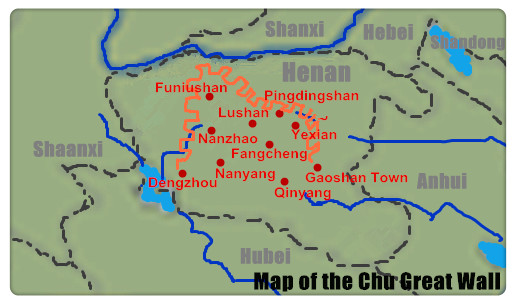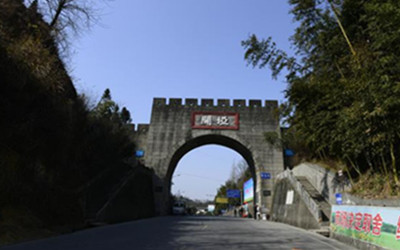Skype: neodalle-travel
Tel: +86 135 7447 2266
E-mail: sales@visitaroundchina.com
Thew Chu Great Wall,also called" Nan Chu Squre Wall"( 南楚方城), is another older series of walls  were built in eastern central China near the Yangtze River.It was built by the Chu Stade in order to defend against the states of Jin and Qi. The Chu State built a 250 kilometer wall in the 600s BC, but later during the expansion of the Qin, expanded it to 400 kilometers.
were built in eastern central China near the Yangtze River.It was built by the Chu Stade in order to defend against the states of Jin and Qi. The Chu State built a 250 kilometer wall in the 600s BC, but later during the expansion of the Qin, expanded it to 400 kilometers.
History of the Chu Great Wall
 During the Spring and Autumn Period of the Zhou Dynasty (770–476 BC), the Chu State expanded westward, spreading across both sides of the Yangtze River. It became the biggest of all the states of that time. It was as big as northern states put together. It reached a maximum size by about 600 BC, and fortresses were built to consolidate the border against the northern Qi State and Jin State.
During the Spring and Autumn Period of the Zhou Dynasty (770–476 BC), the Chu State expanded westward, spreading across both sides of the Yangtze River. It became the biggest of all the states of that time. It was as big as northern states put together. It reached a maximum size by about 600 BC, and fortresses were built to consolidate the border against the northern Qi State and Jin State.
Fortresses were built to conform to the natural terrain, and walls were built to link the fortresses. The walls were not as complex or finely built as the Ming Dynasty Great Wall most tourists are aware of. These were built of whatever material was available in a locale. If dirt was available, it was packed on top of a ridgeline, and it was made likewise with any available rock.
The Chu State Wall and the Qi State Wall are very similar in location and function, and questions remain as to who built and owned what.
During the Warring States Period (476–221 BC) that followed, the Qin State started its westward military conquests. During this time, the Chu added about 150 kilometers to their wall. In 223, the Qin conquered Chu by a surprise attack.
The Chu's Great Wall was called 'Square Wall' (Fangcheng) or 'Bend Wall' (弯城Wancheng)because the wall took the shape of a square with the bottom side, nearest to the Yangtze River, missing.
After the fall of the Chu State, the Qin Empire erected a Great Wall along its northern border, and the Chu wall fell into disrepair. Now all that is left is rubble in some places. Remains of the Chu Great Wall were discovered in Henan Province in 1902.
 Ask Questions ?
Ask Questions ?